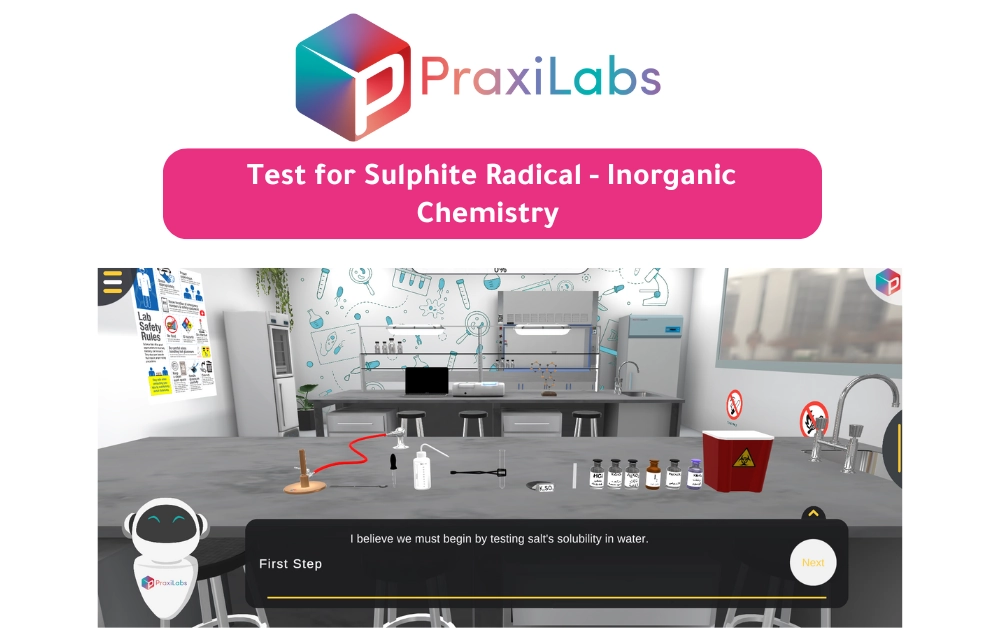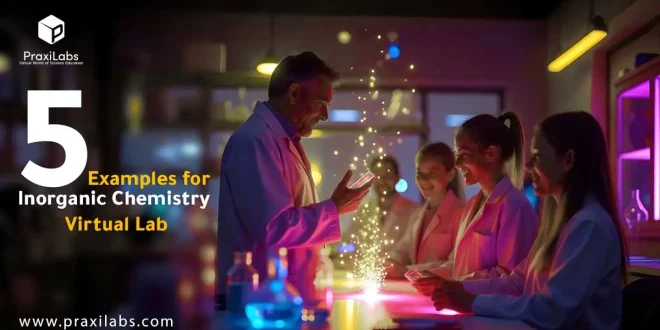Last Updated on September 17, 2025 by Muhamed Elmesery
Conducting inorganic chemistry experiments by using virtual labs enables students to bridge the gap between the theoretical study and the practical laboratory real-world laboratory experience in an interactive and safe learning environment.
In this blog post, we will explore the inorganic chemistry virtual lab, benefits of remote learning with virtual chemistry lab, how virtual labs are enhancing learning through simulation, top 5 examples for inorganic chemistry simulations in PraxiLabs, and more!
Table of Contents
What is Inorganic Chemistry Virtual Lab?
An inorganic chemistry virtual lab is a 3D virtual lab that simulates a real-world laboratory environment to cover topics at inorganic chemistry such as redox reaction, acid-base titration, chemical bonds and more all within a safe environment free from any hazards like exposure to or inhalation of toxic substances.
One of the most vital features of conducting experiments in the inorganic chemistry online virtual lab is the immersive and interactive simulation, which keeps students engaged and focused until the end of the experiment. This, in turn, improves their levels of learning and understanding.
Types of Inorganic Chemistry Virtual Lab
At the inorganic chemistry virtual labs, students study the reactivity, characteristics, and synthesis of inorganic compounds.
Inorganic chemistry virtual lab covers several vital topics such as:
- Chemical formulas.
- Magnetic properties.
- Acid-base chemistry.
- Molecular orbitals.
- Chemical bond formation.
- Electronic properties.
- Redox reactions, and more!

Benefits of Remote Learning with Virtual Chemistry Lab
Using virtual chemistry lab in remote learning revolutionizes the way of education, as it resolves the problem of performing practical experiments remotely:
- It helps students to conduct their chemistry experiments at their home at their own pace, without any pressure.
- By using virtual labs for inorganic chemistry classes online, an online chemistry tutor or the teacher can see how well their students are doing, track their performance in each chemistry experiment, and get insights into how they’re doing.
- The features of chemistry virtual simulations can help teachers who rely on remote learning to identify students who may be struggling with certain steps or who might need more help in order to complete the experiment.
- Online inorganic chemistry tutor or teachers can customize specific inorganic chemistry simulations as homework or quizzes, and collaborate on the virtual experiments during the online sessions to increase students’ understanding and learning outcomes.
Elevate your students’ Learning Retention and Engagement with PraxiLabs’ Chemistry virtual labs!
How Virtual labs are Enhancing Learning Through Simulation
According to a study “the effect of virtual biotechnology labs as an educational tool in supporting students to increase their active learning process “the impact of virtual labs was analyzed.
The content-rich learning materials provided by the virtual laboratories help students understand the theoretical concepts of the experiments.
The results of the study indicate virtual labs improve students’ performance and they are very effective when:
- The reagents and equipment are expensive.
- Ethical concerns.
- Difficulty in result interpretation.
- Time requirement does not fit into the classroom schedule.
- Handling of sophisticated instruments.
- Use of hazardous materials.
The study strongly supported that virtual labs serve as an alternative solution to several problems associated with traditional classroom laboratories, and are therefore effective in improving student performance in formal education settings. classroom education.
PraxiLabs, the 3D virtual lab solution, provides students with access to realistic biology, chemistry, and physics labs and enriches their understanding with a variety of informational and educational content
Examples for Inorganic Chemistry Simulations in PraxiLabs
PraxiLabs provides a wide range of 3d science experiments including basic and advanced inorganic chemistry experiments, let’s explore some of them and know more about their learning objectives:
Test for Chloride Radical
Students learn how to:
- Define and differentiate between Chloride ions and other acid radicals through their chemical formulas.
- Classify inorganic salts according to their acid radicals.
- Compare Chloride ions with other halide group members in terms of chemical structures, properties and reactions.
- Identify salts containing Chloride radicals experimentally.
- Select the appropriate reagents to detect the presence of Chloride radical.
- Balance the chemical equations involved in the reactions.
Test for Bicarbonate Radical
Students learn how to:
- Recognize bicarbonate salts in powder form or solution.
- Apply the principles of laboratory safety measures.
- Differentiate between carbonate and bicarbonate radical.
- Understand various tests to identify the anion present in a given salt.
- Understand the chemical reactions and their balanced equations that take place during each test.
- Acquire the skills necessary to perform the experiment in the real lab once they understand different steps in the procedure.

Test for Sulphite Radical
Students learn how to:
- Define and differentiate between Sulfite ions and other acid radicals through their chemical formulas, properties and reactions.
- Determine the presence of Sulphite radical.
- Identify salts containing Sulfite radicals experimentally.
- Classify them according to their acid radicals.
Test for Iodide Radical
Students learn how to:
- Define and differentiate between Iodide ions and other acid radicals through their chemical formulas.
- Classify inorganic salts according to their acid radicals.
- Compare Iodide with other halide members in terms of chemical structures, and reactions.
- Identify salts containing Iodide radicals experimentally.
- Select the appropriate reagents to detect the the Iodide radical presence.
- Balance the chemical equations of the reactions.
Test for Bromide Radical
Students learn how to:
- Define and differentiate between Bromide ions and other acid radicals through their chemical formulas.
- Classify inorganic salts according to their acid radicals.
- Compare bromide with other halide members in terms of chemical structures, properties and reactions.
- Identify salts containing Bromide radicals experimentally.
- Select the appropriate reagents to detect the Bromide radical presence.
Try PraxiLabs and Experience a Virtual World of Science Education
Pick the Best Virtual Plan or You
Frequently Asked Questions
How do online labs work?
Online labs use virtual simulations that simulate and recreate the real lab environments. These labs depends on interactive tools to make learning more immersive. Online labs allow students to conduct their experiments anytime and anywhere, analyze the data, and understand the scientific concepts clearly.
Is an inorganic chemistry virtual lab accurate?
It depends on the platform you choose for conducting the inorganic chemistry virtual lab experiments. If you choose a trusted platform that provide inorganic chemistry courses virtual labs, The experiments will certainly be accurate.
 PraxiLabs A virtual world of science
PraxiLabs A virtual world of science






